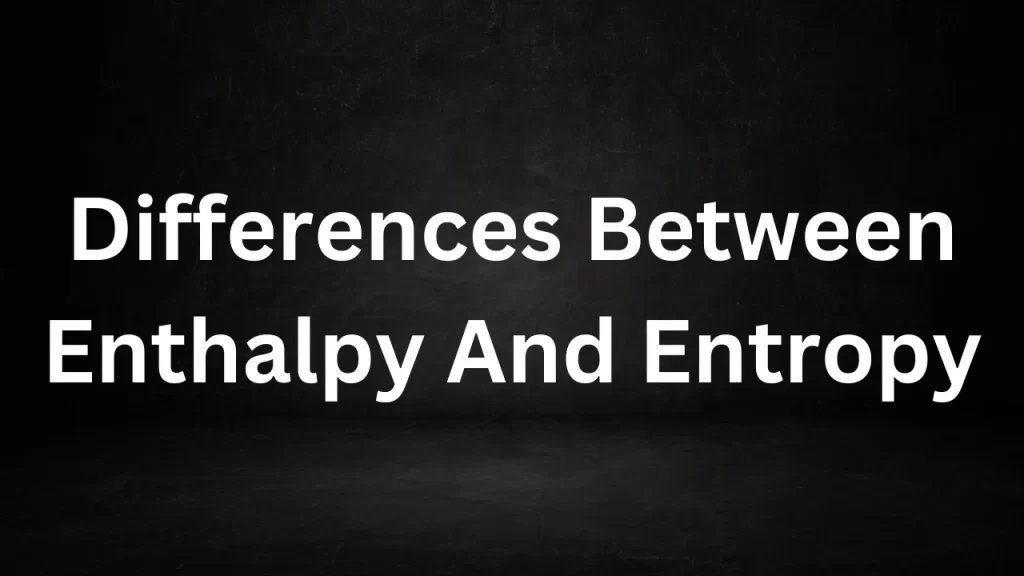Tag: enthalpy and entropy in thermodynamics
Differences Between Enthalpy And Entropy
Differences Between Enthalpy And Entropy: In the realm of thermodynamics, two fundamental concepts play pivotal roles in understanding and describing the behavior of matter and energy: enthalpy and entropy.
These concepts are often used in chemistry, physics, and engineering to analyze and predict the outcomes of various processes. While both enthalpy and entropy are thermodynamic properties, they have distinct definitions and applications.
In this article, we will explore the key differences between enthalpy and entropy and how they contribute to our understanding of the physical world.

Differences Between Enthalpy And Entropy
Enthalpy: The Measure of Heat Content
Enthalpy (H) is a thermodynamic property that represents the total heat content of a system at constant pressure. It includes the internal energy of a system and the energy required to maintain the constant pressure during various processes, such as chemical reactions. Enthalpy is often used to describe heat transfer in chemical reactions and phase changes.
Key characteristics of enthalpy:
- Heat Exchange: Enthalpy accounts for the heat exchanged between a system and its surroundings. In exothermic reactions, the enthalpy change is negative, indicating a release of heat energy. In endothermic reactions, the enthalpy change is positive, signifying an absorption of heat energy.
- Constant Pressure: Enthalpy is particularly useful at constant pressure because it directly relates to the heat exchanged in open systems, like those commonly encountered in chemistry laboratories.
- State Function: Enthalpy is a state function, meaning it depends solely on the initial and final states of a system, not on the path taken to reach those states.
Entropy: The Measure of Disorder
Entropy (S) is another thermodynamic property, but it deals with the degree of disorder or randomness within a system. It is a measure of the system’s tendency to move from a state of order to a state of disorder. Entropy is used to explain why natural processes tend to favor disorder over order.
Key characteristics of entropy:
- Disorder: Entropy is a measure of the randomness or disorder within a system. Higher entropy values indicate a more disordered state, while lower values indicate a more ordered state.
- Second Law of Thermodynamics: The second law states that in any energy transfer or transformation, the total entropy of an isolated system always increases over time. This principle underlines the irreversibility of natural processes.
- Microscopic Level: Entropy is a microscopic property that relates to the statistical distribution of particles and their energy in a system.

Comparison
Now, let’s summarize the key differences between enthalpy and entropy:
1. Definition:
- Enthalpy (H): Measures the total heat content of a system at constant pressure.
- Entropy (S): Measures the degree of disorder or randomness within a system.
2. Focus:
- Enthalpy focuses on heat exchange during chemical reactions and phase changes.
- Entropy focuses on the tendency of natural processes to move towards greater disorder.
3. Symbol:
- Enthalpy is represented by H.
- Entropy is represented by S.
4. Unit:
- Enthalpy is typically measured in joules (J) or kilojoules (kJ).
- Entropy is typically measured in joules per kelvin (J/K).
5. State Function:
- Enthalpy is a state function.
- Entropy is a state function.
Conclusion
Enthalpy and entropy are essential concepts in thermodynamics that provide valuable insights into the behavior of matter and energy in various systems. Enthalpy deals with heat content and exchange, particularly at constant pressure, while entropy quantifies the degree of disorder within a system and explains why natural processes tend towards greater randomness. Understanding the differences between these two properties is crucial for scientists and engineers working in fields where thermodynamics plays a significant role, as it enables them to make predictions and optimize processes more effectively.
Read More
- Periodic Table Class 11
- Molecular Weight Of Sodium Carbonate
- Difference Between Isothermal And Adiabatic Process
- Simple Harmonic Motion Examples
- Molecular Mass Of Calcium
Frequently Asked Questions (FAQs) Differences Between Enthalpy And Entropy
What is enthalpy, and how does it differ from entropy?
Enthalpy (H) is a thermodynamic property that represents the total heat content of a system at constant pressure, including the internal energy and energy required to maintain constant pressure during processes. Entropy (S), on the other hand, measures the degree of disorder or randomness within a system. Enthalpy deals with heat transfer, while entropy deals with the tendency of natural processes to become more disordered over time.
What are the main units of measurement for enthalpy and entropy?
Enthalpy is typically measured in joules (J) or kilojoules (kJ), whereas entropy is usually measured in joules per kelvin (J/K).
How do enthalpy and entropy relate to chemical reactions?
Enthalpy is crucial in describing the heat exchange that occurs during chemical reactions. Exothermic reactions release heat energy, leading to a decrease in enthalpy (ΔH < 0), while endothermic reactions absorb heat energy, resulting in an increase in enthalpy (ΔH > 0). Entropy, on the other hand, explains why chemical reactions tend to move towards states of greater disorder or randomness.
Are enthalpy and entropy related to each other?
Yes, enthalpy and entropy are related through the Gibbs free energy equation (ΔG = ΔH – TΔS), where ΔG is the change in Gibbs free energy, ΔH is the change in enthalpy, ΔS is the change in entropy, and T is the temperature in kelvin. This equation helps determine whether a process is spontaneous (ΔG < 0) or non-spontaneous (ΔG > 0).
Are enthalpy and entropy state functions?
Yes, both enthalpy and entropy are state functions. This means that their values depend only on the initial and final states of a system and are independent of the specific path taken to reach those states.
